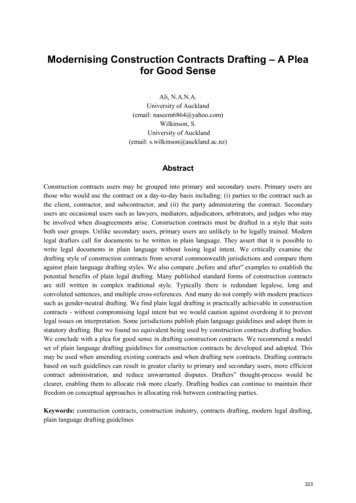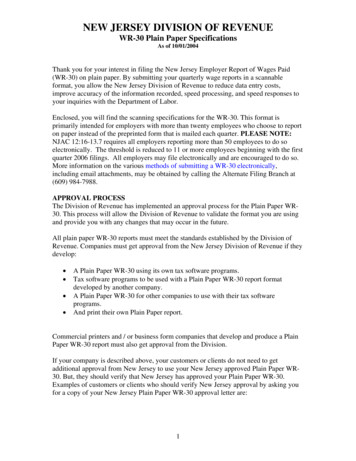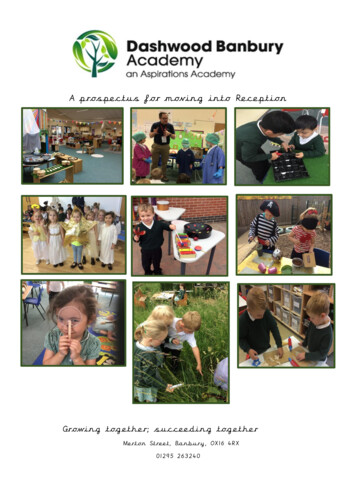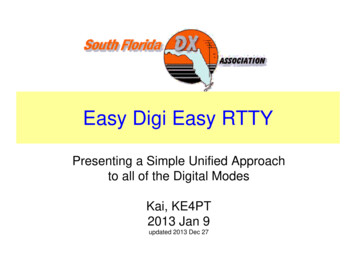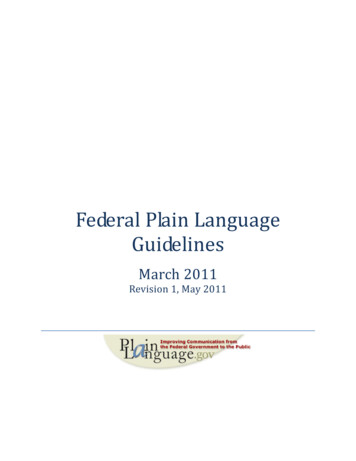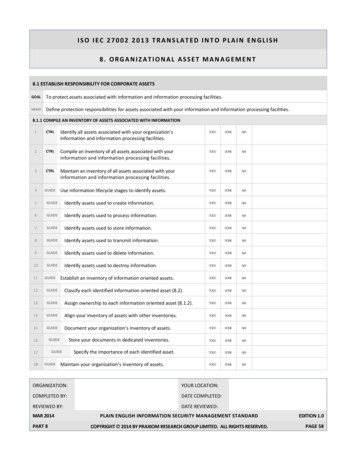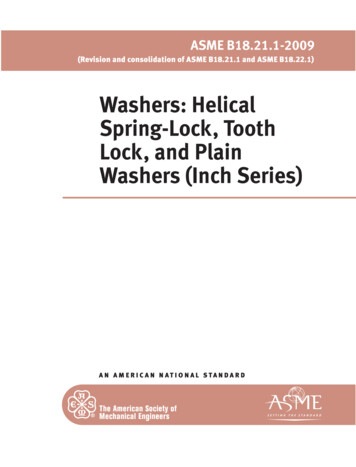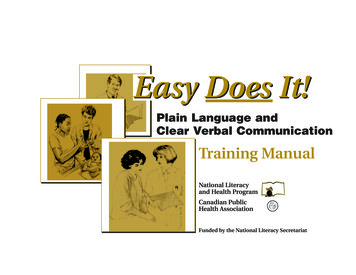
Transcription
Easy Does It!Plain Language andClear Verbal CommunicationTraining ManualNational Literacyand Health ProgramCanadian PublicHealth AssociationFunded by the National Literacy Secretariat
Easy Does It!Plain Language andClear Verbal CommunicationEasy Does It!Plain Language and Clear Verbal CommunicationTraining ManualNational Literacyand Health ProgramTraining ManualCanadian PublicHealth AssociationFunded by the National Literacy SecretariatISBN: 1-894324-00-5Copyright 1998, Canadian Public Health Association. Permission granted for non-commercial reproduction only.For more information contact:Canadian Public Health Association400-1565 Carling Avenue, Ottawa, Ontario, K1Z 8R1Tel:(613) 725-3769Fax:(613) 725-9826Email: comm@cpha.caInternet: www.cpha.caThe Canadian Public Health AssociationThe Canadian Public Health Association (CPHA) is a national, independent, not-for-profit, voluntary association representing publichealth in Canada with links to the international public health community. CPHA’s members believe in universal and equitable accessto the basic conditions which are necessary to achieve health for all Canadians.CPHA’s mission is to constitute a special national resource in Canada that advocates for the improvement and maintenance of personaland community health according to the public health principles of disease prevention, health promotion and protection and healthypublic policy.National Literacy and Health ProgramThe Canadian Public Health Association’s (CPHA) National Literacy and Health Program promotes awareness among healthprofessionals of the links between literacy and health.People with low literacy skills may not understand what health professionals tell them. They may not be able to read healthinformation. Some may not use health services, except in an emergency.CPHA’s National Literacy and Health Program provides resources to help health professionals serve clients with low literacy skills moreeffectively. The program focuses on health information in plain language and clear verbal communication between healthprofessionals and the clients they serve. The National Literacy and Health Program is funded by the National Literacy Secretariat.
Easy Does It!Plain Language and Clear Verbal CommunicationTraining ManualNational Literacy and Health ProgramCanadian Public Health Association
Acknowledgements:The Canadian Public Health Association’s (CPHA) National Literacy and Health Program wishes to thank theNational Literacy Secretariat for funding the development of Easy Does It! A Health Communications TrainingPackage.We also wish to thank the adult learners of the Movement for Canadian Literacy’s (MCL) Learners’ AdvisoryNetwork who shared their stories of navigating the health care system with low literacy skills, Ms. CarolenaGordon, a partner of the Nicholl Paskell Mede law firm in Montreal, Quebec, for her assistance in the developmentof Unit 7, Professional Liability, the literacy practitioners from across the country who provided us with valuablecommunication tips, and the National Literacy and Health Program partners and health providers from acrossCanada who reviewed this resource and offered helpful suggestions.
Table of ContentsUnit 1 Literacy in CanadaLesson 1: Literacy in the 90’s .5Lesson 2: Levels of Literacy in Canada .6Unit 2 Literacy and HealthLesson 3: Direct and Indirect Impacts ofLiteracy on Health .11Unit 3 Clear Verbal CommunicationLesson 4: Definition of Clear VerbalCommunication.19Lesson 5: Clear Verbal CommunicationTips.20Unit 4 What is Plain Language?Lesson 6: Definition and Description.29Lesson 7: Tips.30Lesson 8: Hard and Plain Words.35Lesson 9: Resistances .36Lesson 10: Benefits.37Unit 5 Plain Language Health InformationLesson 11: Why Do We Need It? .41Lesson 12: What Does It Look Like?.42Lesson 13: How Do I Assess It?.46Unit 6 Health EnvironmentsLesson 14: Common Problem Areas.51Lesson 15: How Can I Create an EnvironmentThat is Friendly to People withLow Literacy Skills?.52Unit 7 Professional LiabilityLesson 16: What is the Relationship BetweenHealth Professional Liability, PlainLanguage and Clear VerbalCommunication? .57Lesson 17: Discussion of Some Examples ofCurrent Case Law in Canada .59Unit 8 Implications of Low Literacy Rates for HealthProfessional Education, Direct Service andHealth PolicyLesson 18: Health Professional Education .63Lesson 19: Direct Service .64Lesson 20: Health Policy .66AppendicesAppendix 1:Appendix 2:Appendix 3:Appendix 4:Appendix 5:Answers to Questions .71Tips from Literacy Workers .77Provincial Literacy Coalitions.79Consumer Health Information.81Literacy and Health Programsand Activities in Canada .83Bibliography and Other Resources on Literacyand HealthBibiliography .87Other Resources on Literacy and Health .90
Lois took the medicine bottle out of her purse,hoping for quick relief from her stress.What was it the doctor had said? Lois triedto remember. Was it one pill three times a day?Three pills once a day? When she tried to read thelabel, the words didn’t seem to make sense.The numbers on the label were one and three, so shewas pretty sure that taking three pills a day was okay.Since it was almost supper time, she decided to takeall three right away. It would make her feel better faster!Lois woke up in the hospital several hours later.Luckily, her husband had called an ambulancewhen he couldn’t wake her up. Lois had taken toomuch medicine at one time because she couldn’tremember what the doctor had said, and couldn’tread the medicine label.
Easy Does It!Lois is one of the 48% of adult Canadians who runthe greatest risk of poor health due to one of themost significant barriers to health: low literacy.communicate with your patients. It is not goodenough, for example, to be factually correct if thepeople you serve can’t understand you. It is notenough to feel empathetic toward your clients if youdo not know how to put your concern into practice.2Clear verbal communication is a core clinical skillyou can develop. It is not just a useful attitude oroptional extra.3Accessing health care and health information, aswell as following treatment plans, can be difficultand confusing for health consumers. For people likeLois, however, it can be almost impossible!Complicated forms, hard-to-read brochures,technical jargon, unclear medication instructionsand treatment plans all create barriers to qualityhealth care and patient1 well-being.By using clear verbal communication techniquesand plain language health information, you willimprove the quality of health care you give to all ofyour clients. The ones who will benefit most areclients with low literacy skills.Easy Does It!, A Health Communications TrainingPackage (includes this manual, a video and CD-ROM)has been developed for health providers by theCanadian Public Health Association’s (CPHA) NationalLiteracy and Health Program. The program works inpartnership with 26 national health associations to raiseawareness about the links between literacy and health.Many health providers are caught between shrinkingresources and an expanding workload. If you feelthat you are unable to offer the quality care youwould like, Easy Does It! will show you how changingyour communication habits can help you becomemore effective during the time you can spend withclients.Easy Does It!, offers information, tips, techniquesand stories to help you improve the way you1
EASY DOES IT !Clear and caring communication between providersand clients is the cornerstone of quality health care,and at the heart of the healing process.Easy Does It! is three complete resources in one: amanual, a video and a CD-ROM game. Each resourcecan be used on its own or in conjunction with theothers. If you use the training manual in a class youteach, you may want to show the video when youcome to Unit 3. The CD-ROM game is a valuablecomplement to the information presented in boththe video and Units 4 and 5 of the training manual.Easy Does It!:Introduces you to the links between literacy andhealth.The ability to read, understand and act upon healthinformation is important to healthy living andsuccessful treatment. The implications of lowliteracy for a person’s general health and for thehealthcare system have been called staggering4 anda recipe for disaster.5Here is a short description of each resource:1. The Easy Does It! training manualThe training manual contains eight units: Literacy in Canada Literacy and Health Clear Verbal Communication What is Plain Language? Plain Language Health Information Health Environments Professional Liability Implications of Low Literacy Rates for HealthProfessional Education, Direct Service andHealth PolicyProvides you with effective communication tools.Clear verbal communication techniques, plainlanguage writing and design tips, and readabilityformulas are just some of the practical tools whichwill help make the health information you deliver toyour clients easy for them to understand, rememberand follow.Discusses professional liability as it relates toinformed consent.When people need to undergo medical proceduresor treatments that require their informed consent,the onus is on the health provider to ensure thatpatients have been given the relevant informationand also that they have understood it.In each of these units you will find a unit overview,discussion of each topic and quotes from adultlearners. Most units feature a case study anddiscussion questions. Some units offer practicalexercises to apply what you’ve learned.2
EASY DOES IT !You will find five helpful appendices at the back ofthe manual which include answers to discussionquestions and tips from literacy workers. Abibliography is also provided.As you use Easy Does It!, remember that almost halfof all adults across Canada wage a daily struggleagainst a wall of words which puts their health,safety and well-being at risk. As a health provider,you can make a difference by changing the way youcommunicate with your patients.2. The video, Face to FaceFace to Face is a 20-minute video designed for useby health providers. It features vignettes of realcommunication breakdowns that occur betweenclients and health providers working in the medical,dental and substance abuse fields. The vignettes arelater replayed to demonstrate more effectivecommunication techniques.Away you go, and Easy Does It!3. The CD ROM game, (plain word) (plain word) is a word game created by CPHA’sNational Literacy and Health Program to help healthproviders simplify the language they use with theirclients.In this exciting CD ROM format, players can chooseto play with difficult health-specific terms where aword such as contusion is matched with a morecommonly understood word such as bruise. Playerscan also choose to play with non-medical languagewe tend to use every day. Why say utilize when youcan say use ?3
EASY DOES IT !References:1. The terms patient and client will be usedinterchangeably throughout this manual.2. Suzanne Kurtz, Jonathan Silverman, Juliet Draper.Teaching and Learning Communication Skills inMedicine. (Oxon, UK: Radcliffe Medical Press, 1998) 36.3. Kurtz, Silverman and Draper 4.4. Ruth Parker, “What Is Health Care Literacy?,”Proceedings of Health Literacy: A NationalConference (Washington DC: Pfizer Inc., June 3, 1997)2.5. David W. Baker, “The Impact of Health Literacy onPatients’ Overall Health and Their Use of HealthcareServices,” Proceedings of Health Literacy: A NationalConference (Washington D.C.: Pfizer Inc., June 3,1997) 6.4
Low literacy skill levels are found not just among marginalized groups, but also among largeproportions of the entire adult population.Reading the Future: A Portrait of Literacy in CanadaStatistics Canada, 1996UNIT 1 Literacy in CanadaLESSON 1 Literacy in the 90’sBetween 1994 and 1997, the Organization forEconomic Co-operation and Development(OECD), Statistics Canada, and HumanResources Development Canada (HRDC) releasedthree reports on adult literacy:that 48%* of Canadian adults have reading problemsand may not be able to fully participate in manydaily activities of Canadian life.Literacy Skills for the Knowledge Society,3 publishedin 1997, presents data from an additional fiveparticipating OECD countries, as well as an analysisof the links between adult literacy levels andeconomic performance in industrialized nations.Literacy, Economy and Society, Results of the FirstInternational Adult Literacy Survey (IALS),1 acomparative study of adult literacy, published in1995, presents data from seven OECD countries. Itportrays literacy as an important issue facing anumber of member countries and demonstrates astrong plausible link between literacy and acountry’s economic potential.These reports show that inequalities in literacy arehighly associated with inequalities in income and* 48% reflects the 22% of adults reading at Level 1 and the 26%of adults reading at Level 2, as explained in Lesson 2.Reading the Future: A Portrait of Literacy in Canada,2published in 1996, provides a deeper analysis of theCanadian data of the IALS study. It includes thedistribution of literacy skills by age group,geographic region and language. This study revealedIn this UNIT you will findLESSON 2:Levels of Literacy in Canada .6Current Statistics.8Case Study 1 .95
EASY DOES IT !occupational status: people with low levels ofliteracy are restricted in their access to certain kindsof employment, while those with higher literacyskills are more likely to attain high-paying jobs.4Strong literacy skills allow workers to face thechallenges of changing markets so that they and thecompanies they work for maintain an economicedge in an increasingly competitive environment. What is literacy?LESSON 2Levels of Literacy in Canada UNIT 1Prose (e.g., editorials, fiction);Document (e.g., job applications, maps, trainschedules);Quantitative (e.g., balancing a cheque book,completing an order form).Survey results identified five levels of literacy whichare outlined in Lesson 2 of this unit.The definition of literacy has advanced well beyondthe three “R’s” of reading, writing and arithmeticlearned at school. A new, more practical definition ofliteracy which focuses on the ability to useinformation from printed texts has emerged as aresult of the recent research. Literacy is the ability tounderstand and use printed information in dailyactivities, at home, at work and in the community—to achieve one’s goals, and to develop one’sknowledge and potential.5 This focus places thepractice of literacy in a realistic context. Moreover,this new definition places literacy on a continuum ofabilities that recognizes various degrees of literacyskill among a well-defined range of reading materials.The IALS survey measured a person’s ability toperform increasingly difficult informationprocessing tasks. The following results and examplesof tasks required in the prose section of the surveywill introduce you to the five levels of literacyidentified by IALS. Clearly, a large number ofCanadian adults lack the literacy skills needed tofunction adequately in today’s society.1. Level OneVery low literacy skills: 22%Readers were able to correctly locate one piece ofinformation in a text at least 80% of the time. Forexample, a level one task was to determine themaximum duration recommended for taking aspirin,based on the instructions printed on an aspirin bottle.In measuring literacy skills accurately, the IALSsurvey assessed participants’ ability to deal withthree different kinds of reading materials:6
UNIT 1EASY DOES IT !Canadian adults who read at level one have very lowreading skills and are generally aware that they havea reading problem.Canadian adults who read at level three aregenerally considered to have the minimum requiredliteracy skills for today’s workplace.2. Level Two4. Levels Four and Five*Low literacy skills: 26%Readers were able to locate one or more pieces ofinformation and compare and contrast thisinformation in a short text at least 80% of the time. Forexample, a level two task was to provide an answerbased on information about the characteristics of agarden plant, from a written article.Excellent literacy skills: 20%Readers were able to correctly provide severalanswers from abstract texts which containeddistracting information not relevant to the question,at least 80% of the time. For example, a level fourtask was to answer a brief question on how toconduct a job interview, requiring the reader to reada pamphlet on recruitment interviews and integratetwo pieces of information into a single statement. Alevel five task was to answer a question that useddifferent phrasing from that used in the original text.Canadian adults at level two can read, but not well.They avoid situations where they would need toread unfamiliar texts. For example, if new safetyprocedures were introduced in the workplace inprint format, level two readers may have difficultyunderstanding the information.Canadian adults who read at levels four and fivehave the ability to integrate several sources ofinformation or solve complex problems. They canmeet most of the literacy demands of today’sknowledge-based society.3. Level ThreeAdequate literacy skills: 33%Readers were able to correctly identify, compare andcontrast several pieces of information located indifferent paragraphs at least 80% of the time. Forexample, a level three task was to read a set of fourmovie reviews and state which was the leastfavourable.* Once analysis of the IALS data began, it became clear thatthere was such a small proportion of the population at thehighest level (Level Five), that the distinction between LevelsFour and Five could not be supported with the availablesample size. IALS analysts combined these two levels to ensurethe statistical reliability of results.7
EASY DOES IT !UNIT 1Current StatisticsThe 1994 IALS testing of a representative sample* ofCanadian adults has shown that nearly half ofCanada’s adults have low literacy skills, renderingthem functionally illiterate.Official LanguageParticipants took the survey in the official languageof their choice.Here are statistics of Canadian adults with lowliteracy skills (Levels 1 & 2) broken down by:English .45%French:Province of Quebec .57%Other Provinces .61%Age group16 to 25 .36%26 to 35.39%36 to 45.34%46 to 55.53%56 to 65.65%Over 65.80%Immigration status59% of Canadian immigrants have low literacy skills.It is interesting to note, however, that a higherpercentage of Canadian immigrants (23%) fall intolevels 4 and 5 than the national average (20%).As you can see, older Canadians have much lowerlevels of literacy than their younger counterparts.Fully 80% of seniors have some trouble witheveryday reading demands. Broken down further,more than half of those over 65 are in the very low(Level 1) literacy category.RegionAtlantic provinces .53%Quebec.57%Ontario.44%Western provinces .42%* The sample did not include residents of the NorthwestTerritories and Yukon, inmates of institutions, persons livingon Indian reserves or full-time members of the CanadianArmed Forces.8
Case Study 16Mr. Carson*called hisdoctor at thehospital for a refill ofhis heart pills. Thedoctor was away and aresident, Dr. David H.Frankel, who didn’t knowMr. Carson, took the call.Dr. Frankel asked Mr. Carsonthe name of the drug he was taking.Mr. Carson didn’t know. Dr. Frankelsuggested several likely prescriptions, but Mr.Carson couldn’t remember.Discussion Questions:1. What do you think was Mr. Carson’s greatesthealth risk: his heart condition or hisinability to read?2. If you were the resident in this case, whatwould you have done to help Mr. Carson?Frustrated, Dr. Frankel asked Mr. Carson toread him the label of his medicine bottle. Mr.Carson couldn’t pronounce it, so began tospell it out, letter by letter.Dr. Frankel looked in astonishment as theword appeared on his note pad: TABLETS.* The name has been changed.Answers on page 719
EASY DOES IT !References:1. Statistics Canada. Literacy, Economy and Society,Results of the First International Adult LiteracySurvey (Ottawa: Statistics Canada, 1995).2. Statistics Canada. Reading the Future: A Portrait ofLiteracy in Canada (Ottawa: Statistics Canada, 1996.3. Statistics Canada. Literacy Skills for the KnowledgeSociety (Ottawa: Statistics Canada, 1998).4. “Literacy Skills of Canadian Youth,” Human ResourcesDevelopment Canada Applied Research Bulletin 4 . 1(Winter-Spring 1998) : 4.5. Statistics Canada. Literacy, Economy and Society 1.6. Ingfei Chen. “Teach Your Patients Well,” Hippocrates(March 1994) 34.10UNIT 1
Literacy is related to health. Persons with higher skills may maintain better health through theirability to understand and interpret health information. They may also be better able to exercisepreventive health practices and detect problems so that they can be treated earlier, or makeappropriate choices amongst health care options.Highlights from the Second Report of the International Adult Literacy Survey:Literacy Skills for the Knowledge Society, 1997UNIT 2 Literacy and HealthLESSON 3 Direct and Indirect Impacts of Literacy on HealthThe relationship between health and educationhas been clearly established in many studiesover the past several years. In a 1995 study,1the Test of Functional Health Literacy in Adults(TOFHLA) was used as a measure of health literacyamong 3,000 patients in emergency rooms andchronic care clinics at Grady Memorial Hospital inAtlanta, Georgia and Harbor-UCLA Medical Centerin Los Angeles, California.TOFHLA researchers confirmed the literacy andhealth link with the following observations:1. People with low literacy skills were found to betwice as likely to state that their overall health waspoor than were those with adequate literacy skills.2. People with low literacy skills had difficulty withoral communication as well as with writteninformation. This conclusion was drawn whenTOFLA results for patients treated in theemergency room revealed that less than 40% ofpatients with low-literacy skills knew theirdiagnosis immediately after seeing the doctor.3. Over a two-year period following the study, 48%of patients with marginal to low literacy skillswere hospitalized in contrast to 15% of patientswith adequate literacy skills.4. Over 80% of the study patients in Atlanta whowere over the age of 60 were identified as havinglow literacy skills - which means that thepopulation with the most health problems wasalso the least able to deal with them.In 1989, the Ontario Public Health Association(OPHA) published a report entitled Literacy andHealth Project: Making the World Healthier and SaferIn this UNIT you will findCase Study 2 .1611
EASY DOES IT !As a resident, I was caring for a number ofoutpatients, one of whom was a black woman inher mid-20s with severe hypertension. Her bloodpressure control was poor, necessitating weeklyvisits. Every week, I adjusted and readjusted themedications we had available without substantialimprovement of her blood pressure. Frustrated, Iadmitted her to the hospital. To my astonishment,when she was on bed-rest and on the same antihypertensive drug regimen, her blood pressure cameunder prompt control. Drugs were discontinuedand good control was maintained even when shewas allowed to walk about the ward. It was thenthat I learned that she could not read theprescription labels. My detailed weekly adjustmentscould not be implemented. She was not noncompliant, but unable to comply. 3for People Who Can’t Read. In this report, OPHAidentifies two major impacts of literacy on health:direct and indirect.Direct ImpactsDirect impacts2 of low literacy on health stem frompoor print and verbal communication. Improvingthe way you communicate with your patients cansignificantly reduce the effects of these directimpacts on health consumers with low literacy skills.What are the direct impacts of low literacy onhealth?1) Incorrect use of medications.2) Not following health instructions.3) Safety risks.Incorrect use of MedicationsPeople who can’t read medication instructions oftensuffer from underdoses and overdoses as well as theinappropriate mixing of both prescription and overthe-counter (OTC) medications.Health providers are often frustrated by clients’apparent lack of compliance with their treatmentplans. As Dr. Arthur H. Rossof discovered, however,non-compliance can be the result of patients notunderstanding what the health provider expectsthem to do.UNIT 2Seniors, who receive about 25 - 40% of prescriptionmedication, may not be able to follow theirmedication regimes because they can’t readmedication labels, open pill vials or keep track ofdosing intervals. This results in more visits to thedoctor, more laboratory tests, more medication,repeat hospital admissions, and lengthened nursinghome stays. The bill adds up to more than 9 billionper year for the Canadian economy. Human costsrange from seniors’ loss of personal autonomy tounnecessary morbidity and mortality. 412
UNIT 2EASY DOES IT !For more detailed information on the impacts oflow literacy skills on the health and welfare ofCanadian seniors, please consult CPHA’s guide,Working with Seniors with Low-literacy Skills:Practical Strategies for Health Providers. 5Indirect ImpactsThe indirect impacts7 of literacy on health aredeeply rooted in the economic and socialconditions of people’s lives. They include: poverty; unhealthy lifestyle practices; stress; low self-esteem; dangerous work environments; lack or inappropriate use of health services.Not Following Health InstructionsWhen low-literacy adults try to understand andfollow complicated instructions on over-thecounter items such as baby formula, mistakes willresult. Adult learners have identified the misuse ofbaby formula as a direct impact of their low literacyskills on the health of their children. Some parentshave failed to dilute concentrated formula whileothers diluted ready-to-use formula. The result?Babies may suffer severe health problems.Since the indirect impacts of literacy on health areso far-reaching, a broad range of long-term socialprograms and supports are needed to improve thequality of life of adults with low literacy skills.Safety RisksHome and workplace accidents are more likely tooccur when people are unable to read and understandsafety warnings and instructions. Many occupationalinjuries are due, in part, to the hazards of the job. ASudbury worker was recently killed, however, as adirect result of his inability to read the labels on somechemical containers. Low literacy was cited in theinquest as the major factor in his unfortunate death.6PovertyWhile having low literacy skills is not the only reasonfor poverty, it is a major factor. Education is a basicrequirement if people expect to find work and earn anincome which allows them to avoid or escape poverty.A background study8 for the Social AssistanceReview Committee (SARC) confirmed the linksbetween poverty and health status with evidencethat poor people die younger, are ill more often andhave fewer years of life free from disability.13
EASY DOES IT !Unhealthy Lifestyle PracticesPeople with low literacy skills are more likely thanothers to have unhealthy lifestyle behaviours. 9 Forexample, they: Smoke more; Have poor nutrition; Drink more coffee; Are less likely to engage in regular physicalactivity; Do not use seatbelts; Among women, are less likely to practice breastself-examination and obtain pap smears; Are less likely to have ever had a blood pressurecheck; Are less likely to have a fire extinguisher, smokedetector, or a first aid kit at home.Stress and Low Self-EsteemTrying to function in a society where the ability toread is taken for granted and, in fact, a requirementfor many basic daily activities, creates high levels ofstress and low self-esteem in people with lowliteracy skills. Their reading problems result infeelings of vulnerability and lack of control overtheir lives, and deny them access to informationintended for and available to the public. This leadsto frustration, anger, and feelings of shame. 10UNIT 2Many jobs available to people with low literacy skillsare low paying and of a temporary nature. Theabsence of employment security and adequateincome compounds the stress of coping with aninability to read. The National Anti-PovertyOrganization (NAPO) has identified stress as t
Unit 3Clear Verbal Communication Lesson 4: Definition of Clear Verbal Communication.19 Lesson 5: Clear Verbal Communication . well as following treatment plans, can be difficult and confusing for health consumers. For people like Lois, however, it can be almost impossible! . can also choose to play with non-medical language we tend to .

